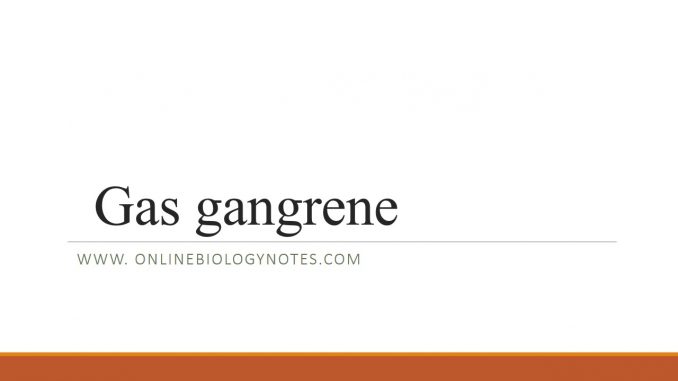
Gas gangrene- causative agents, Virulence factors, Pathogenesis, Clinical features, Laboratory diagnosis, Treatment, Prevention and Control
Gas gangrene:
- Gas gangrene is also known as clostridial myonecrosis. It becomes prominent during First World War. Clostridium perfinges is the primary causative agent which contaminates the open wound and causes tissue necrosis.
Clostridial wound infection is of three types.
- Simple contamination: when Clostridium present in injured tissue but without evidence of infection. Such contamination is simple and common. The wound heals by first intention without sequels.
- Clostridial cellulitis: It is characterized by fowl, seropurulent infection of depth of wound without muscle involvement.
- Clostridial myonecrosis: it is characterized by infection of muscle and severe toxemia.
Causative agents:
- Clostridium perfinges, C. novyi, C. septicum, C. histolytica, C. sordelli, C. bifermentaus
- Anaerobic Streptococci
- Streptococcus aureus
- Vibrio vulnificus
- Bacteroides
- Pseudomonas aeruginosa
- coli
- Klebsiella pneumonae
Virulence factor of Clostridium spp
- Alpha (α)-toxin: it is a lecithinase which split lecithin present in cell membrane into phosphorylcholine and diglyceride. It is produced by Clostridium perfingens type A
- Beta (β)-toxin: it necrotizing lethal toxin
- Epsilon (ε)- toxin: it is a permease
- Iota (η) toxin: it is lethal necrotizing toxin
- Hyaluronidase: it digest hyaluronic acid
- Collagenase: It digest collagen fibre of sub cutaneous tissue
- θ-toxin: it has hemolytic and necrotizing effects
- DNase: it digest nucleotide
- Enterotoxin: it induce enteric gastroenteritis
Pathogenesis:
- Clostridium cannot multiply and produce disease in normal tissue because of high oxidation-reduction potential of circulating blood and tissue which is more than necessary for growth of anaerobic bacteria.
- The central factor that allows anaerobes to grow in wound is tissue anoxia.
- Facultative organisms such as coli, Proteus, that may be present in wound which reduce the oxidation-reduction potential facilitating the growth of anaerobic bacteria like Clostridium.
- Once the infection is established in immune-compromised host, toxin produced by the organism lead to weakening of host defense.
- The pathogenesis of perfinges type A is associated with production toxins, hyaluronidsea and collagenase.
- Collagenase damage the unaffected muscle, that supply the aminoacids and peptide for bacterial growth.
- The speed of infection is facilitated by hyaluronidase produced by perfinges and other bacteria present in wound.
A gas composition:
Hydrogen- 5.9%
Carbondioxide- 3.4%
Nitrogen- 74.5%,
Oxygen- 16.1%
Clinical features:
- Incubation period: varies from 7 hours -7 days
Symptoms:
- Pain: Pain develops early in the region of wound and increases in intensity with progressive swelling and edema
- fever
- The wound is edematous, tender and exudate profuse serous discharge
- Blisters with foul-smelling discharge
- Gas bubble: bubbles of gas appear in discharge, crepitus may become evident in tissue and skin become white and marbled
- pale skin that quickly turns gray, dark red, purple, or black
- excessive sweating
- The pulse rate increases
- Moderate pyrexia
- Vomiting
- The blood pressure falls and peripheral venous collapse often make venipuncture impossible
- Profoundly toxemic and shocked
- Patient collapse, but remain mentally alert and anxious
- The syndrome terminates with sudden death due to circulatory failure.
Complications:
- permanent tissue damage resulting in amputation
- Jaundice: yellow skin and eyes
- Organ failure: liver damage and kidney failure
- Multi bacterial infection
- coma
- death
Lab diagnosis
Specimen: wound exudates, pus, tissue
1. Smear preparation and Microscopy: gram positive spore forming rod on Gram staining
2. Serology: Rapid immunological test for identification of Clostridial products in wound exudates. Such as ELISA
3. Inhibition test: A specific sialidase inhibition test give result in 2-6 hours
4. Culture:
- Skin culture on BA: to test for the presence of Clostridium perfringens and other bacteria
- Cooked meat Agar: gas bubble due to H2S production
5. Haematological test: blood tests shows an abnormally high WBCs count, which can indicate an infection
6. Nagler reaction
7. Biochemical tests: Catalase +ve, Oxidase +ve
8. Imaging: routine X-ray, (MRI) or arteriogram etc to visualize tissues and check for the presence of gas
9. Surgery: to evaluate the spread of gas gangrene within the body
Treatment:
- Early and adequate surgary
- Amputation
- penicillin
- combination of penicillin and clindamycin
- combination of metronidazole and clindamycin to patient allergic to penicillin
- Hyperbaric Oxygen
- Polyvalent antitoxin
Prevention:
- Maintain proper Hygiene
- Early and adequate cleaning of contaminated wound and cover with bandage together with antimicrobial drugs
- Toxoid vaccine
- Maintain healthy habits
- Avoiding tobacco products
- Control blood sugar level
Reference:
- https://en.wikipedia.org/wiki/Gas_gangrene
- http://www.healthline.com/health/gas-gangrene#prevention7
- https://medlineplus.gov/ency/article/000620.htm
- http://emedicine.medscape.com/article/217943-treatment#d8
- http://emedicine.medscape.com/article/217943-clinical#b5
- http://www.nytimes.com/health/guides/disease/gas-gangrene/overview.html?mcubz=0
